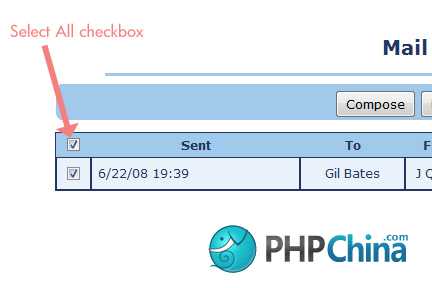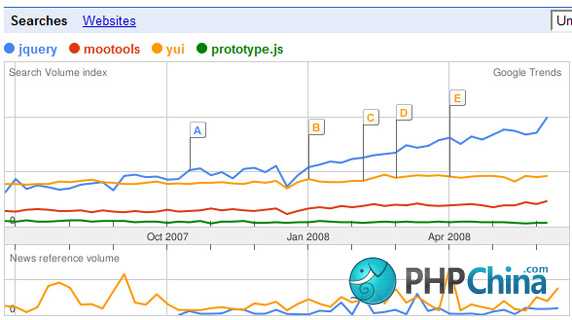选择
jQuery 的根本在于它在页面上选择和操作某些元素的能力。从某种意义上说,需要围绕这些对象才能构建出有效的 jQuery 库。因此,面对一个普通 HTML 页面上提供的大量选项,您需要一种方法来快速高效地选择您需要在页面上使用的元素,只选择需要的元素(不多也不少)。jQuery 如我们所愿地提供了一些强大的选择方法,帮助我们在页面上寻找和选择对象。jQuery 创建了它自己的选择语法,并且这种语法很容易掌握。
(以下大部分示例所使用的函数将留在下一篇中讨论,不过它们的功能应该是很直观明了的)。
根本上来讲,jQuery 中的选择过程就是一个巨大的过滤过程,页面上的每个元素都经过这个过滤器,它将返回一个匹配的对象,或一个可以遍历的匹配对象的数组。
排在前面的 3 个示例是最常用的。它们通过 HTML 标记、ID 或 CLASS 查找对象。
HTML
要获取一个页面中所有匹配的 HTML 元素的数组,您仅需将 HTML 标记(不带括号)传递到 jQuery 搜索字段。这是查找对象的 “快速但是粗糙” 的方法。如果要将属性附加到通用的 HTML 元素,这种方法是很有用的。
清单 5. HTML 选择
// This will show every <div> tag in the page. Note that it will show
// every <div>, not the first matching, or the last matching.
// Traversing Arrays is discussed later in the article.
$("div").show();
// This will give a red background to every <p> tag in the page.
$("p").css("background", "#ff0000"); |
ID
正确的页面设置要求页面上的每个 ID 都是惟一的,虽然有时并不是这样(有意或无意)。使用 ID 选择时,jQuery 仅返回第一个匹配的元素,因为它要求您遵循正确的页面设计。如果您需要将一个标记附加到同一页面上的几个元素,应当选择使用 CLASS 标记。
清单 6. ID 选择
// This will set the innerHTML of a span element with the id of "sampleText" to "Hi".
// Note the initial "#" in the command. This is the syntax used by jQuery to search
// for IDs, and must be included. If it is excluded, jQuery will search for the HTML
// tag instead, and with no <sampleText> tags on a page, will ultimately do
// nothing, leading to frustrating and hard-to-find bugs (not that that has ever
// happened to me of course).
$("#sampleText").html("Hi"); |
CLASS
CLASS 与 ID 非常相似,不同之处是它可以用于一个页面上的一个或多个元素。因此,尽管受到同一页面的每个元素只有一个 ID 的限制,同一页面上的多个元素仍然可以拥有相同的 CLASS。这使您可以在一个页面上跨多个元素执行函数,并且只需传入一个 CLASS 名称。
清单 7. CLASS 选择
// This will create a red background on every element on the page with a CLASS of
// "redBack". Notice that it doesn't matter which HTML element this "redBack"
// CLASS tag is attached to. Also notice the period in the front of the query
// term -- this is the jQuery syntax for finding the CLASS names.
$(".redBack").css("background", "#ff0000");
<p class="redBack">This is a paragraph</p>
<div class="redBack">This is a big div</div>
<table class="redBack"><tr><td>Sample table</td></tr></table> |
合并搜索条件
可以在一个搜索中,将以上的 3 个搜索条件和下面的所有过滤器合并起来。通过使用 “,” 分隔每个搜索条件,搜索将返回与搜索词匹配的一组结果。
清单 8. 合并搜索
// This will hide every <p>, <span>, or <div>.
$("p, span, div").hide(); |
更多的过滤器
虽然在 jQuery 中,这 3 个搜索参数无疑是最常用的,但还有许多其他搜索参数,可以帮助您在一个页面上快速查找所需的元素。这些过滤器以 “:” 开头,表明它们是 jQuery 搜索词中的过滤器。尽管它们也可以作为独立的搜索条件,但是设计它们的目的是将它们和以上 3 个搜索条件一起使用,从而可以调整搜索条件以找到您需要的特定元素。
清单 9. 更多的过滤器
// This will hide every <p> tag on a page
$("p").hide();
// This will hide the first element on a page, no matter its HTML tag
$(":first").hide();
// Notice how these can be used in combination to provide more fine tuning of
// search criteria. This will hide only the first <p> tag on a given page.
$("p:first").hide(); |
可以将多个过滤器用作搜索元素。虽然在这里我没有列举所有的过滤器(这是 API 页面的任务),但其中一些过滤器在处理页面和搜索元素方面非常方便。
我将 主要关注 Selection 包中一些非常重要的过滤器,它们就是表单 元素过滤器。如今的富 Internet 应用程序比较关注表单及包含在其内的元素(文本字段、按钮、复选框、单选按钮等),它们从服务器收集和传输信息,或收集信息并传输到服务器。由于它们在 RIA 中的重要作用,在当今的 Web 应用程序中,这些过滤器在处理 jQuery 时非常重要。
这些过滤器和前面介绍的过滤器的工作原理是一样的,并且也是以 “:” 开头,表明它们是过滤器。同样,它们也可以和其他搜索过滤器一起使用,以细化搜索条件。因此,一个 “:text” 搜索过滤器将返回页面上的每个文本字段,而一个 “.largeFont:text” 搜索过滤器仅返回页面上作为 “largeFont” 类的一部分的文本字段。这允许进一步细化和操作表单元素。
表单过滤器也包括元素的每个属性,了解这方面的知识对开发人员有好处。因此像 “:checked”、“:disabled” 和 “:selected” 等搜索过滤器将为特定的搜索进一步细化搜索条件。
遍历
现在,您已经学会如何搜索和过滤页面上的所有元素,接下来需要一种高效的方法来遍历结果,进一步处理元素。自然,jQuery 提供了几种遍历搜索结果的方法。
第一个也是最常用的遍历方法是 each() 函数。这和 “for loop” 的功能是一样的,遍历每个元素并通过迭代递增元素。此外,循环中的每个元素的引用可以通过 “this”(用于一般的 JavaScript 语法)或 $(this)(用于 jQuery 命令)来实现。
让我们看看下面的示例。
清单 10. each 循环
// Will loop through each <p> tag on the page. Notice the use of the
// inline function here -- this is analogous with the anonymous classes in Java.
// You can either call a separate function, or write an inline function like this.
var increment = 1;
$("p").each(function(){
// now add a paragraph count in front of each of them. Notice how we use the
// $(this) variable to reference each of the paragraph elements individually.
$(this).text(increment + ". " + $(this).text());
increment++;
}); |
因为搜索结果存储在一个数组中,您肯定希望函数遍历该数组,就像处理其他编程语言的数据对象一样。因此,要查找一个给定搜索结果的长度,则可以在该数组上调用 $().length。清单 11 展示了更多的数组遍历函数,可适用于其他编程语言的数组遍历。
清单 11. 其他数组函数
// the eq() function lets you reference an element in the array directly.
// In this case, it will get the 3rd paragraph (0 referenced of course) and hide it
$("p").eq(2).hide();
// The slice() function lets you input a start and an end index in the array, to
// create a subset of the array. This will hide the 3rd through 5th paragraphs on the
// page
$("p").slice(2,5).hide(); |
除了这些数组遍历函数之外,jQuery 还提供了一些函数,使您可以查找嵌套在搜索词周围的元素。为什么这很有用呢?例如,我们常常需要在图片的旁边嵌入一个文本标签,或在表单元素旁边嵌入一个错误消息。使用这些命令可以查找特定的表单元素,然后通过将表单元素放置在下一个元素(span 标记)中,把该错误消息直接放置在表单元素旁边。清单 12 显示了这种设计的一个示例:
清单 12. 示例 next() 函数
<input type=text class=validate><span></span>
function validateForm()
{
$(".validate:text").each(function(){
if ($(this).val()=="")
// We'll loop through each textfield on the page with a class of "validate"
// and if they are blank, we will put text in the <span> immediately afterwards
// with the error message.
$(this).next().html("This field cannot be blank");
});
} |
综合学到的知识
要了解如何结合使用以上知识,可以查看本文包含的示例应用程序(参见 参考资料 小节)。
现在简单介绍一下示例应用程序。我将在本系列所有文章中使用这个示例应用程序,因为它使用了大量不同的 jQuery 示例,并且几乎所有人都熟悉这个应用程序 — 一个处理 Web 邮件的富 Internet 应用程序。这个示例应用程序是一个简单的邮件客户机,它利用 jQuery 给用户这样的感觉:该电子邮件客户机非常类似于桌面应用程序。在最后一篇文章结束时,您将明白这个简单的应用程序是如何为用户制造这种感觉的,并且明白使用 jQuery 实现这个功能是多么简单。
本文的重点是 “Select All”/“Deselect All” 复选框,它们出现在 Web 邮件表(下面突出显示)的左侧列的顶部。当选中该复选框时,它将选择该列的每个复选框;取消选择该复选框时,它将取消选择该列的所有复选框。
图 2. “Select All” 复选框

清单 13. 综合学到的知识
<!-- The first step is creating the Select All checkbox itself.
we give it a unique ID on the page -->
<input type=checkbox id=selectall>
<!-- The next step is giving each of the rows their own checkbox.
we put each row's checkbox into the 'selectable' class, since there can be many rows,
and we want each of the rows' checkboxes to have the same behavior. -->
<input type=checkbox class=selectable>
<!-- The final step is bringing it all together with some jQuery code. -->
// remember that all jQuery setup code must be in this document.ready() function,
// or contained within its own function in order to function correctly.
$(document).ready(function(){
// We use the jQuery selection syntax to find the selectall checkbox on the page
// (note the '#' which signifies ID), and we tell jQuery to call the selectAll()
// function every time someone clicks on the checkbox (we'll get to Events in a
// future article).
$("#selectall").click(selectAll);
});
// This function will get called every time someone clicks on the selectall checkbox
function selectAll()
{
// this line determines if the selectall checkbox is checked or not. The attr()
// function, discussed in a future article, simply returns an attribute on the
// given object. In this case, it returns a boolean if true, or an undefined if
// it's not checked.
var checked = $("#selectall").attr("checked");
// Now we use the jQuery selection syntax to find all the checkboxes on the page
// with the selectable class added to them (each row's checkbox). We get an array
// of results back from this selection, and we can iterate through them using the
// each() function, letting us work with each result one at a time. Inside the
// each() function, we can use the $(this) variable to reference each individual
// result. Thus, inside each loop, it finds the value of each checkbox and matches
// it to the selectall checkbox.
$(".selectable").each(function(){
var subChecked = $(this).attr("checked");
if (subChecked != checked)
$(this).click();
});
} |
结束语
jQuery 是 Web 应用程序开发社区中非常受欢迎的 JavaScript 库,并且随着富 Internet 应用程序越来越普及,它将变得更加重要。由于许多公司都在线迁移内部应用程序,并且在线移动日常的桌面应用程序(包括文字处理器和电子表格),能够简化开发并实现跨平台支持的 JavaScript 库将成为设计应用程序架构的必选技术。
这份关于 jQuery 的系列文章的第一篇介绍了 jQuery 语法,如何在您自己的 JavaScript 代码中正确使用 jQuery,以及如何在结合使用其他库时避免冲突。此外,本文还介绍了 jQuery 搜索和选择语法,它们是其他 jQuery 功能的基础。它使您可以简单快捷地找到所需的页面元素。文章也谈到了如何遍历搜索结果,使您可以逐个地处理元素。jQuery 的这两个方面是本系列下一篇文章的基础,同时也是所有 jQuery 代码的基础。
最后介绍了一个演示应用程序,它是一个富客户端 Web 邮件应用程序。在本文,您通过学到的 jQuery 知识创建了 Select All/Deselect All 复选框,并且仅需几行代码就可以创建一个在许多 Web 站点上都非常常见的小部件。
下一篇文章将把一些交互添加到这个示例 Web 应用程序。您将学习如何处理页面事件(单击元素、按钮点击、组合框选择等),如何从页面上的元素获取值,以及如何修改页面上的标准 CSS 来更改颜色,布局等,而不需重新加载页面。


















最新评论